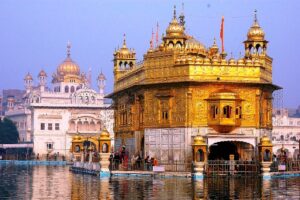
Amritsar, historically known as Rāmdāspur and colloquially as Ambarsar, is a city in north-western India which is the administrative headquarters of the Amritsar district- located in the Majha region of the Indian state of Punjab.
Many sacred Sikh shrines can be found in the holy city of Amritsar. Of particular importance are the five sacred pools in this city. These are called sarovars and it is the practice of some Sikhs to have a dip in all five of these holy pools.These five holy Sarovars are: Amritsar, Santokhsar, Ramsar, Kaulsar, Bibeksar
Amritsar is home to the Harmandir Sahib (commonly known as the Golden Temple), the spiritual and cultural centre for the Sikh religion. The foundation of the town was laid in 1577 by Guru Ram Das (1534-81) when he inaugurated the digging of the holy tank Amritsar (amrit = nectar, sar = pool) on a piece of land which, according to some sources, was purchased from the residents of the neighbouring village of Tung during the time of Guru Amar Das (1479-1574).
Guru Ram Das encouraged people from various trades and professions to take up residence here. The town expanded further under his son and successor, Guru Arjan (1563-1606), who completed and lined the tank and constructed in its middle the holy shrine, Harimandar, now famous as the Golden Temple and also had two more tanks, Santokhsar and Ramsar, excavated nearby.
It was on the bank of Ramsar that the fifth Guru carried out the compilation of the Adi Granth (later Guru Granth Sahib). With the installation on 16 August 1604 of the Granth Sahib in the Harimandar, the shrine and the sarovar Amritsar surrounding it together became the central attraction of the town and a site for pilgrimage by the Sikhs from far and near.
This important Sikh shrine attracts more visitors than the Taj Mahal with more than 100,000 visitors on weekdays alone. The city also houses the Akal Takht, the highest seat of earthly authority of the Khalsa, and the committee responsible for the upkeep of Gurdwaras.
Sikhs, Hindus, Jains, Christians and Buddhists from around the World daily visit the Complex and its shrines. One shrine – the Ath-sath Tirath was so named to allow Hindu visitors or those Sikhs who had been raised as Hindus to complete the arduous pilgrimage to 68 Holiest shrines in one visit.
The free kitchen here (called Langar in Punjabi ) is one of the largest free kitchens to be run anywhere in the world. The concept of langar was initiated centuries ago by Guru Nanak, the founder of Sikh religion. At the Langar, no one goes hungry – and everybody gets a hot meal regardless of caste, creed and religion.
The Ramtirth temple situated at Amritsar is believed to be the Ashram site of Maharishi Valmiki, the writer of Ramayana. According to the Hindu mythology, Goddess Sita gave birth to Lava and Kusha, sons of lord Rama at Ramtirth ashram. Large numbers of people visit Ramtirth Temple at annual fair. Nearby cities to Amritsar, Lahore and Kasoor were said to be founded by Lava and Kusha, respectively.
During Ashvamedha Yagna by Lord Rama, Lava and Kush captured the ritual horse and tied Lord Hanuman to a tree near to today’s Durgiana Temple. During Navratra festivities it is considered to be auspicious by Hindu population of the city to visit that temple.
Amritsar has been chosen as one of the heritage cities for HRIDAY – Heritage City Development and Augmentation Yojana scheme of Government of India.
Source:
http://www.sikhiwiki.org/index.php/Amritsar
https://en.wikipedia.org/wiki/Amritsar
http://w.ndtvimg.com/sites/22/2016/03/12143031/960-2.jpg
http://www.sikhiwiki.org/index.php/Five_sarovars_of_Amritsar
http://dailysikhupdates.com/Amp/sri-harmandir-sahib-ji-a-beautiful-blissful-place/
http://amritsartemples.in/2011/11/prachin-mandir-of-baghwan-valmiki-ji/#.WdympFuCzIU


